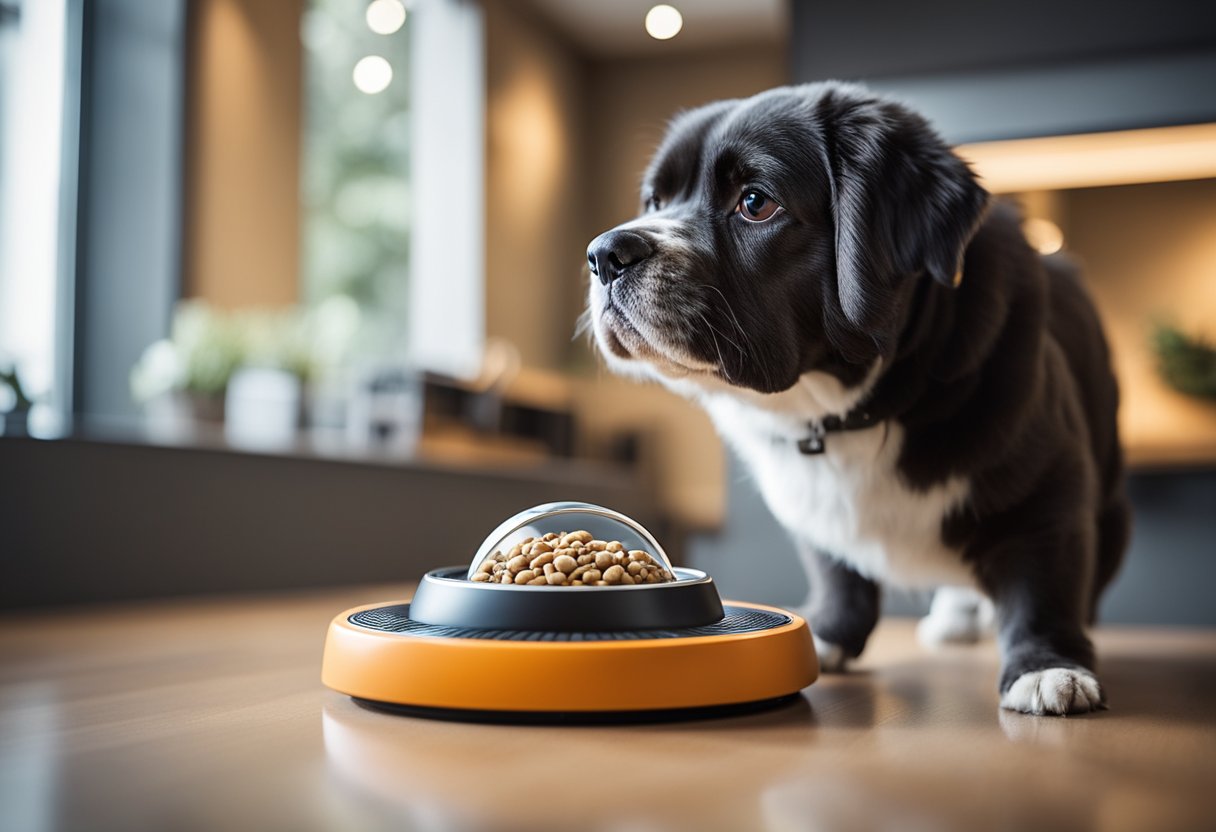In today’s connected world, pet care has gone high-tech, offering new ways to interact with and care for our furry friends. Integrating smart pet devices into our daily routines promises to enhance the well-being of our pets and add convenience to our lives. From automatic feeders and interactive cameras to smart doors and health monitoring wearables, there’s an array of gadgets designed to keep our pets happy, healthy, and safe, even when we’re not home.
Using smart devices for pets also simplifies the management of their care. It allows us to be proactive about their health, offers mental stimulation during our absence, and provides invaluable peace of mind regarding their safety. Setting up these devices can be a breeze, and customizing them to fit perfectly into both our lives and our pets’ routines creates a seamless experience for everyone.
Key Takeaways
- Smart pet devices offer convenience and help manage pet care effectively.
- Proper setup and customization integrate technology into pets’ routines seamlessly.
- Regular troubleshooting and maintenance ensure the devices function optimally.
Benefits of Smart Pet Devices

We’ve all seen how technology has revolutionized our lives, but it’s not just us that can benefit – our pets can too. Smart pet devices offer a range of advantages that can enhance interaction with our furry friends, monitor their health, and improve their safety.
Enhanced Interaction
Smart devices enable us to bond with our pets even when we’re not physically present. For instance, pet cameras allow us to see and speak to our pets through two-way audio systems, ensuring they feel loved and engaged throughout the day.
Health Monitoring
It’s crucial for us as pet owners to stay on top of our pets’ wellbeing. Devices such as smart collars track activity levels and can even remind us when it’s time for their medication, helping us keep our pets in tip-top shape.
Safety Improvements
Our pets’ safety is always a top concern. Thankfully, smart tech such as GPS trackers embedded in collars provide real-time location updates, giving us peace of mind by alerting us if our pets wander too far from home.
Choosing the Right Smart Devices for Your Pet

When we look for ways to improve our pets’ lives and streamline our daily routines, smart devices are often at the forefront of our choices. Remember, the right gadgets can make a world of difference for both our furry friends’ well-being and our peace of mind.
Feeding Solutions
Smart pet feeders are a game-changer, allowing us to schedule meals and control portions even when we’re away. Consider the Dogness Smart Pet Feeder for its ease of use and convenient features, such as remote feeding through a mobile app.
- Features to look for:
- Remote feeding capabilities
- Portion control
- Scheduling abilities
- Reliable connectivity
Entertainment and Exercise
Our pets need stimulation and activity to stay healthy and happy. Smart toys that move unpredictably or can be remotely operated ensure our pets are entertained even during our busy hours.
- Top picks:
- Toys that can be controlled via smartphone
- Devices that dispense treats to reward activity
Comfort and Care
A smart thermostat keeps our pet’s environment at a comfortable temperature, and devices like GPS trackers, like the Whistle, ensure their safety by allowing us to monitor their whereabouts.
- Essentials for comfort and care:
- Climate control with smart thermostats
- GPS trackers for location monitoring
Setting Up Your Pet’s Tech Environment
As we gear up to integrate smart devices into our pets’ daily lives, it’s essential to understand the setup process. We’re going to walk through the basics of installation, syncing these gadgets with our smartphones, and tailoring the settings to fit our furry friends’ unique needs.
Installation Basics
To start, carefully unbox each device and locate the user manual or quick start guide. These documents provide crucial information tailored to your product, such as the ideal placement for cameras or sensors and how to secure mounts. Ensure you have a stable Wi-Fi connection throughout your home to keep devices like smart pet feeders and pet cameras functioning properly. Some basic tools you might need could include:
- Screwdriver
- Level
- Drill (for wall-mounted devices)
- Batteries or charging cables
Smartphone Integration
Next, it’s time to pair these devices with our smartphones. Most smart pet devices come with a companion app, which allows us to control and monitor them remotely. Typical steps involve:
- Downloading the app from the App Store or Google Play.
- Creating an account or logging in.
- Following in-app instructions to connect each device to your phone.
This process usually includes scanning a QR code located on the device or manually connecting to it through Bluetooth or Wi-Fi.
Customizing Settings
Once devices are installed and paired with our phones, we’ll dive into customizing the settings. This can range from setting feeding schedules on automated feeders to adjusting sensitivity levels on motion-activated cameras. Key areas to focus on might be:
- Feeding: Schedule meal times and portion sizes.
- Surveillance: Set alerts for motion detection or noise.
- Comfort: Adjust smart thermostats to keep your pet cozy.
By fine-tuning these settings, we can ensure our smart pet devices not only enhance our pets’ comfort and safety but also fit seamlessly into our daily routine.
Incorporating Devices into Daily Routines
We’ve all seen how smart technology can streamline our day-to-day lives. Now, let’s explore how we can extend this convenience to our furry friends, making our time with them both more enjoyable and efficient. By integrating smart pet devices into daily routines, we can enhance meal times, make play sessions more engaging, and ensure their health and well-being is always monitored.
Meal Times
Utilizing smart feeders can transform how we manage our pets’ diets. Program your pet’s feeding schedule into the device to dispense the right amount of food at the right time, ensuring they’re fed consistently even when you’re not home. For example, a Litter-Robot can ensure your cat has fresh litter after every meal, tying cleanliness to their eating routine.
Play Sessions
Interactive toys and gadgets can take playtime to the next level. Enrich your pet’s activity time with devices that mimic prey movements or throw balls automatically, so even when you’re busy, your pet stays active and happy. Employing devices like automatic laser pointers or app-controlled toys ensures your pet remains engaged and exercised.
Health Checks
Today’s pet devices can also keep a watchful eye on your pet’s health. Smart collars with GPS can track their activity level, while other devices monitor vital signs or even dispense medication. Staying informed about their daily physical activities helps us catch any irregularities early. Implementing these devices daily means routine checks become a seamless part of your pet’s life.
Troubleshooting and Maintenance

Integrating smart pet devices into our daily routine can be a game-changer for both convenience and our pets’ well-being. However, like any technology, we might encounter hiccups that need troubleshooting. It’s essential for us to stay informed on common issues, understand the importance of software updates, and maintain proper cleaning and care to ensure these devices function at their best.
Common Issues
Experience tells us that even the most reliable smart pet devices may occasionally act up. If we’re having trouble with an automated pet feeder, the first step is to check for blockages or mechanical failures which can often result from unclean components or battery issues. For smart pet doors, connectivity problems can arise, possibly needing a system reset or range check.
- Feeder problems:
- Jammed kibble chute
- Unresponsive dispenser
- Pet door glitches:
- Poor signal range
- Irregular opening/closing
Software Updates
Keeping our devices up-to-date with the latest software is crucial. These updates not only introduce new features but also fix existing bugs and enhance security. Regularly checking for and installing updates can prevent many operational issues. For instance, if a smart pet wearable isn’t syncing properly, an update might be all that’s needed.
- Check for updates:
- In-app notifications
- Manufacturer’s website
Cleaning and Care
Cleaning and care keep our devices running smoothly and prevent complications due to dirt and wear. Automated litter boxes, for example, require regular emptying and cleaning to prevent malfunctions. By adhering to a cleaning schedule, we safeguard hygiene and prolong the lifespan of the devices. Below is a simple routine we could follow:
- Weekly:
- Wipe down exterior surfaces
- Clean dispensing mechanisms
- Monthly:
- Deep clean all removable parts
- Inspect for wear and tear
Taking care of our smart pet devices ensures they take care of our furry friends effectively.
Frequently Asked Questions
Ever find yourself pondering the seamless integration of cutting-edge pet tech into your daily life? We’re here to guide you through a hassle-free transition. From ensuring your furry friend’s feeding schedule to smartly securing their well-being, these frequently asked questions have got you covered.
What are the best practices for incorporating smart pet feeders into daily schedules?
To seamlessly integrate smart pet feeders into our daily routines, we should establish regular feeding times that align with our pet’s dietary needs. Consistent meal times, aided by the precision of automated feeding systems, ensure our pets are well-fed even when busy schedules keep us away.
How can I use smart surveillance to ensure the safety of my pets?
Employing smart home cameras and monitors allows us to keep a vigilant eye on our pets. We can remotely observe their behavior, set up alerts for unusual activity, and even communicate with them, making sure they’re safe and sound at all times.
What features should I look for in a smart toy to keep my pet entertained?
When choosing a smart toy, we seek out features like interactivity, durability, and the ability to customize play sessions. Toys with engagement sensors can adapt to our pet’s activity level, keeping them entertained and mentally stimulated even when we’re not home.
How can pet health monitoring devices alert me to potential issues?
Health monitoring devices are designed to track and analyze our pet’s activity and vitals. Devices with exceptional tracking capabilities can alert us to changes in behavior or health, providing early warnings about potential health issues that may warrant a visit to the vet.
What are the steps to connect a smart collar to my phone?
To pair a smart collar with our phone, we typically download the collar’s companion app, create an account, and follow the in-app instructions to sync the device via Bluetooth or Wi-Fi. This connection allows us to monitor their location and activity through our smartphone.
How do automated pet doors enhance my pet’s independence?
Automated pet doors grant our companions the freedom to come and go as they please. These doors, often linked to smart pet wearable technology, provide secure access for our pets while keeping unwanted visitors out, balancing independence with safety.

